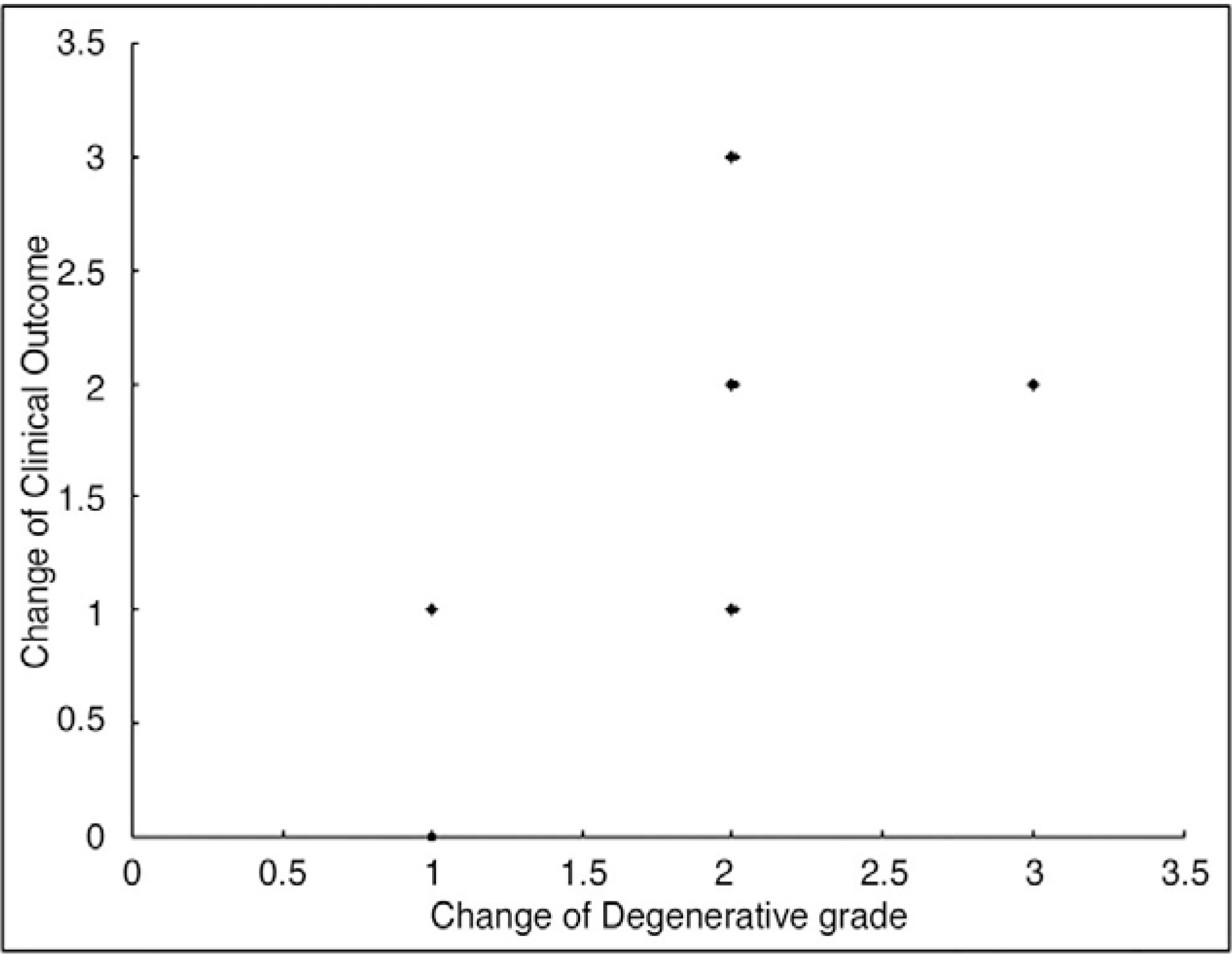J Korean Soc Spine Surg.
2008 Mar;15(1):38-43. 10.4184/jkss.2008.15.1.38.
Correlation Between Clinical Result and Adjacent Segment Degeneration After Lumbar Spinal Fusion
- Affiliations
-
- 1Department of Orthopedic Surgery, Chungnam National University, School of medicine, Research Institute for Medical Sciences, Daejeon, Korea. jyyang@cnu.ac.kr
- KMID: 1482842
- DOI: http://doi.org/10.4184/jkss.2008.15.1.38
Abstract
-
STUDY DESIGN: Retrospective study
OBJECTIVES
To determine the relationship between clinical outcome and adjacent segment degeneration (ASD) after lumbar fusion. SUMMARY OF LITERATURE REVIEW: Few studies have analyzed the correlation between clinical outcomes and ASD.
MATERIALS AND METHODS
Between January 2000 and December 2004, 217 patients who underwent lumbar spinal fusion (>2 years of follow-up) were evaluated. The patients were divided into 2 groups: one-segment (A) and two-segment (B). The UCLA grading scale was used to evaluate the prevalence of ASD on radiography. The association between clinical outcome and ASD was evaluated by Spearman's correlation.
RESULTS
ASD occurred in 11.6% (13/112) of patients in group A and 15.2% (16/105) of patients in group B. The number of cases which progressed to more than 2 levels of the degenerative grade were 0 cases in group A and 13 cases (81.3%) in group B. In A, 5 out of 13 ASD cases downgraded one level in their clinical outcomes. In B, all 16 ASD cases downgraded more than one level in their clinical outcomes. Worsening in degenerative grade, was correlated with worse clinical outcome (Spearman's rho = 0.829, P <0.05).
CONCLUSIONS
The association of clinical outcomes with ASD after fusion showed a significant correlation, especially association with ASD after multiple segment fusion.
Figure
Cited by 1 articles
-
Old and New Fashion: Minimally Invasive Spine Surgery for Adjacent Segmental Spinal Stenosis after Luque Sublaminar Wiring and Posterolateral Fusion - Case Report -
Seung-Pyo Suh, Jaewon Lee, Chang-Nam Kang
J Korean Soc Spine Surg. 2014;21(4):179-182. doi: 10.4184/jkss.2014.21.4.179.
Reference
-
1). Lehmann TR, Spratt KF, Tozzi JE, et al. Long-term follow-up of lower lumbar fusion patients. Spine. 1987; 12:97–104.
Article2). Nagata A, Schendel MJ, Transfeldt EE, et al. The effects of immobilization of long segmentsof the spine on the adjacent and distal facet force and lumbosacral motion. Spine. 1993; 18:2471–2479.3). Whitecloud TS 3rd, Davis JM, Olive PM. Operative treatment of the degenerated segment adjacent to a lumbar fusion. Spine. 1994; 19:531–536.
Article4). Hilibrand AS, Carlson GD, Palumbo MA, Jones PK, Bohlman HH. Radiculopathy andat segments adjacent to the site of a previous anterior cervical arthrodesis. J Bone Joint Surg Am. 1999; 81:519–528.5). Quinnell RC, Stockdale HR. Some experimental observations of the influence of a single lumbar floating fusion on the remaining lumbar spine. Spine. 1981; 6:263–267.
Article6). Gelalis ID, Kang JD. Thoracic and lumbar fusions for degenerative disorder. Orthop Clin N Am. 1998; 29:829.7). Cunningham BW, Kotani Y, McNulty PS, Cappuccino A, McAfee PC. The effect of spinal destabilization and instrumentation on intradiacal pressure: an in vitro biomechanical analysis. Spine. 1997; 22:2655–2663.8). Lee CK, Langrana NA. Lumbosacral spine fusion: a biomechanical study. Spine. 1984; 9:574–581.9). Weinhoffer SL, Guyer RD, Herbert M, Griffith SL. Intradiscal pressure measurements above an instrumented fusion. A cadeveric study. Spine. 1995; 20:526–531.10). Baba H, Furusawa N, Imura S, Kawahara N, Tsuchiya H, Tomita K. Late radiographicfindings after anterior cervical fusion for spondylotic myeloradiculopathy. Spine. 1993; 18:2167–2173.11). Lee CK. Accelerated degeneration of the segment adjacent to a lumbar fusion. Spine. 1988; 13:793–799.
Article12). Strayer LM, Risser JC, Waugh TR. Result of sine fusion for scoliosis twenty-five years or more after surgery. Proceedings of the Scoliosis Research Society. J Bone Joint Surg Am. 1969; 51:205–206.
- Full Text Links
- Actions
-
Cited
- CITED
-
- Close
- Share
- Similar articles
-
- Surgical Treatment of Adjacent Segment Degeneration after Spinal Fusion in Degenerative Lumbar Disc Disease
- Revision Surgery for Spinal Stenosis Developed at the Adjacent Segment after Lumbar Fusion
- A Comparison of Adjacent Segment Diseases Above One Versus Above Two Vertebral Segment after Spinal Fusion of the Degenerative Lumbar Disease
- Analysis of Risk Factors for Adjacent Segment Degeneration Occurring More than 5 Years after Fusion with Pedicle Screw Fixation for Degenerative Lumbar Spine
- Survival Rates and Risk Factors for Cephalad and L5-S1 Adjacent Segment Degeneration after L5 Floating Lumbar Fusion : A Minimum 2-Year Follow-Up



